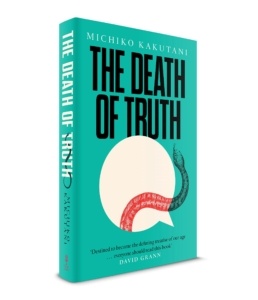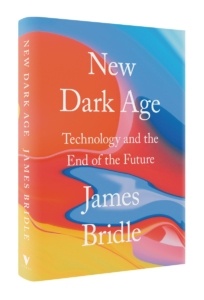It seems like the last remaining truth, the last fact we can agree on, is that reality itself is slipping away. We don’t breathe the same truths but are suffocating in epistemic bubbles, cut off from each other in separate and competing realities. The substance of the world itself is breaking, and with it going civility, journalism, and democracy. In its place we have post-truth, reality apathy, and alternative facts. There’s fake news, fake audio and fake video, deepfake porn, fake followers on Twitter and fake friends on Facebook. There are bots masquerading as human and humans disguised as bots. Images are increasingly augmented, manipulated, intensified, if not altogether algorithmically generated. Perhaps our only shared reality is of a world that feels fake.
This, at least, is the general despair of a certain cohort who desire a “shared, consensus reality,” and whose proclamations of fakeness become more dramatic. Futurist Mark Pesce warns not just of the end of truth but of the “last days of reality.” The “end of reality” is also the title of an Atlantic article that claims that “the current president has further hastened the arrival of a world beyond truth, providing the imprimatur of the highest office to falsehood and conspiracy.” A Technology Review article on deepfakes cites an NYU professor stating, “If we aren’t careful, [fake imagery] might result in the end of the world.” Echoing this, Florida Senator Marco Rubio recently said that “in the old days, if you wanted to threaten the United States, you needed 10 aircraft carriers and nuclear weapons and long-range missiles,” but today “all you need is the ability to produce a very realistic fake video that could undermine our election, that could throw our country into tremendous crisis internally and weaken us deeply.”
As long as mass media has existed, there have been complaints about social acceleration, uncertainty, and the loss of a real, knowable world
Perhaps the doomiest and thirstiest fake-take is a BuzzFeed story from earlier this year by Charlie Warzel with Aviv Ovadya which warns of a coming “infocalypse” that “will really scare the shit out of you.” They describe fake media as approaching a “critical threshold of addictive and toxic misinformation” that “threatens to undermine a cornerstone of human discourse: the credibility of fact,” likening fake news to the Manhattan Project and the atomic bombs that killed hundreds of thousands of people in Japan in World War II.
As the epistemic dystopianism genre goes, we’ve entered a post-truth era, one where everything is dangerously fake and the only solution is a righteous retreat back to truth. The blame usually goes to Donald Trump, social media, or — incredibly — postmodern social theory. But the so-called “fact-based community” rarely produces convincing evidence that there ever was a “truth” era that we are now “post.” Is our current crisis of the real so new or different from eras past?

Earlier this year, not long after her departure as chief book critic for the New York Times, Michiko Kakutani published a book called The Death of Truth: Notes on Falsehood in the Age of Trump. Kakutani argues that social media filter bubbles are to blame for the rise of nationalism, tribalism, dislocation, fear of social change, and hatred of outsiders, positing that the success of Trump’s deceptions could only be explained by the failure of truth.
The contents of the book, like its title, demonstrate the hyperbole of the post-truth genre. There is the typical obsession with Russians, calling them “the master manipulators” of social media, wielding the “dark arts” of propaganda and the “ravenous monster” of fake news. There are sloppy allusions to our “primitive” impulses and our “reptile brains” serving as explanations for our epistemic habits. And there are the standard complaints about the “embrace of subjectivity,” the primacy of feeling over fact, evidenced by selfie culture, a favorite New York Times target.
Kakutani blames the unraveling of reality partly on “the Postmodernists,” a set of academics who, in her story, somehow convinced culture to turn away from facts and evidence. It is mostly unclear which postmodern theories are being engaged with and what their causal links are to our current realities. Rather, Kakutani imagines postmodernism as a unified, ruinous specter whose theorizing is somehow both obscure and impossibly efficacious. (The book’s sloppy account of postmodernism is well outlined here and here.) The scapegoating of postmodernism is telling — it helps contextualize the false novelty of claims that the world is newly fake.
Kakutani misses how poststructural and postmodern thought has long been a response to science’s unwarranted claims of neutrality and objectivity. Yes, sometimes this work really is just a set of stylistic whims and nihilistic postures or arguments for full epistemic relativism. But the core of much of what was popular and is still taught — Foucault, Haraway, Harding, Latour, and so on — uses empirical evidence to show that objectivity is never as such. These theorists show how accepted notions of truth are deeply rooted in cultural contingencies, and that interrogating these notions helps better articulate reality than accepting false objectivism with blind faith. This work was not “post-truth,” but rather called for smaller, more local truths instead of absolute or universal claims made from a posture of neutrality.
When Kakutani declares that “it was ridiculous … to argue that a researcher’s cultural background could affect verifiable scientific facts,” she is ignoring the work of social constructionists who have demonstrated how reality is created through practice rather than something simply given beforehand. What Kakutani calls “academia’s embrace of postmodernism” could more accurately be described as “some in academia became convinced that objectivity is claimed where it can’t be and that causes social problems.”
Truth’s contestability means that the meaning of your life, or anyone else’s, is a question that is possible to ask, and possible to get wrong
These postmodern theorists were grappling with truth as something always in flux. They articulated how the crisis of what is real and true is not something felt uniquely in our own moment, but traceable through all of modernity. The BuzzFeed article above quotes “a senior federal employee tasked with investigating information warfare” about the state of truth: “I think about it from the sense of the Enlightenment — which was all about the search for truth … what you’re seeing now is an attack on the Enlightenment — and Enlightenment documents like the Constitution — by adversaries trying to create a post-truth society. And that’s a direct threat to the foundations of our current civilization.”
Our current moment tends to misunderstand the Enlightenment, which challenged a world governed by epistemic dogma, handed down by religion and royalty, that held truth as something frozen, complete, and beyond debate. The Enlightenment was an effort to treat truth as something that wasn’t a given but needed to be worked on, and could be failed at. The experience of the Enlightenment was and remains itself a crisis of reality.
Epistemic uncertainty isn’t something we are newly experiencing. It has, again, lingered through modernity. The modern rise of science and democracy, the industrial revolutions, globalization, the furthering of transportation, urbanism, and mass media all multiply that uncertainty by providing access to other cultures, ideas, and ways of knowing. Technology warps what we think is real faster than we can cope, which continues to bring both possibility and despair. Truth’s contestability means that the meaning of your life, or anyone else’s, is a question that is possible to ask, and possible to get wrong. You can fail to become the person you’re supposed to be. Truth, in short, was and continues to be radically contested. That was always the point.
People often say Neil Postman’s Amusing Ourselves to Death (1985) was prophetic in describing a world where truth wasn’t just hidden but largely irrelevant, as it feels today. But he wasn’t predicting the future as much as describing his present, too: a Reagan era dominated by the information economy of print journalism and television. This is the immediate pre-internet arrangement that the web was born into, and, predictably, replicated. Many of the old media vanguards who today complain about the post-truth internet were, rightly, Postman’s targets then.
And before Postman, other thinkers came to the same conclusions about their own eras. Historian Daniel J. Boorstin wrote about the falsity of his time in The Image (1962), targeting, among other things, radio news. Before that, theorist Siegfried Kracauer said much the same of the years between the first and second World Wars, warning about the implication of the rise of images in newspapers and magazines. Richard Hofstadter, in Anti-Intellectualism in American Life (1963), located many of these trends in America’s early history.
As long as mass media has existed in the West, there have been complaints about social acceleration, uncertainty, and the loss of a real, knowable world. In other words, our current conversations about the loss of reality are familiar; while each writer attempts to sound innovative, the concerns are evergreen. If the term “infocalypse” is useful, it is as a synonym for modernity, where truth is always two decades ago and dying today, and a new dark age always on the horizon.
If the feeling that you don’t know what is real and true isn’t so new, but rather a running commentary throughout all of modernity, why is this meme so viral now? What the genre is ultimately selling is truth as an identity, facts as an aesthetic. Most literally, the New York Times sells a “Truth” T-shirt on its website.
So many journalists and pundits have failed to describe our world accurately, and the inability to outline a coherent account of our reality can be felt as the impossibility of coherence at all. But the world isn’t really as blurry as their cloudy vision. Maybe we’d prefer if current political conditions were all a cruel joke or surreal dream, but the motives that shape our world are sincere and their effects are abundantly clear. Rather than ascribe Trump’s victory to postmodern bogeymen, it seems more accurate to point out that he won because he is openly racist and that stance has been popular enough. Perhaps “post-truth” is the condition of being wrong multiplied by your own sense of expertise.
In a tic that typifies many complaining about the death of truth, Kakutani described Trump as the leader of a “bizarro-world,” as if he were not actually president. It’s telling that the “reality-based community” continuously finds reality surprising and debasing. Perhaps the world isn’t newly fake as much as those who once had the role of describing the world are increasingly ignorant of it. Those critics and pundits who have been the most unable to comprehend the shape of the world, who can’t see what’s coming or where we’re going, are declaring the loudest that there must be no truth at all, presumably in order to maintain their own right to gatekeep facts and reality. I am not wrong, no — it is reality which is torn; it is the world itself that is suddenly unreliable.
“Post-truth” is the condition of being wrong multiplied by your own sense of expertise
There is something too easy in proclamations like the truth is the truth. “This is an apple,” a CNN advertisements reads under a picture of an apple, “some people might try and tell you that it’s a banana … but it’s not,” selling the fiction that facts are as simple as identifying fruit. In the end, the narrative that everything is fake and post-truth seeks to extend the legitimacy of increasingly irrelevant knowledge-producers. If truth is on the verge of going extinct, you can sell special access. As I write this, there is debate over whether a video shared by the Trump administration of an altercation during a White House press briefing was doctored or not. The Zapruder-like analysis of each frame assumes that evidence one way or the other would affect public opinion of Trump or CNN, or the press’s ability to cover the administration. It reinforces the fiction that press briefings and “hard card” access theater is any real check on power, reducing real critique of growing authoritarianism to a mere spell-check.
To see truth as dying and reality as increasingly fake is self-flattering. It feels good because it allows readers to affirm that they are smart, a stable island of reasonable good in a chaotically bad world. If reality itself is in crisis, then you can posit yourself as the savior, the slayer of chaos dragons, by simply continuing to do what you were already doing: Consume the same news that misinformed you about the election and that today can only describe reality as bizarre. Support those politicians and political strategies that lost. Fight for the recent past that gave us Trumpism in the first place. Float adrift in a bubble of those who have nothing left to do but complain about bubbles.

At first, New Dark Age by James Bridle, also released this year, seems like another entry in the end of truth genre. As the title indicates, it shares some of the hyperbole: the book is organized into a series of speculative nightmare scenarios brought by new technologies, producing a sort of local-TV-news-meets-Black-Mirror effect. The next big internet virus, Bridle warns, “might be there, right now, breeding in the CCTV camera in your office, or in the wi-fi-enabled kettle in the corner of your kitchen.” He seems to argue that the internet, precisely because it is so full of indiscriminate information, is leading us into a “dark” time of fundamentalism, simplistic narratives, conspiracy theories, and post-factual politics.
The book also shares some of the genre’s tendency toward false novelty. While Bridle provides lots of interesting Victorian-era history, he rarely cites from the vast body of social theory — from Weber to Beck, Mumford, Virilio, and Bauman, to name a few — that makes claims similar to his about risky technologies and an unknowable world. But to the book’s credit, the “new” in “new dark age” doesn’t assert that there is something new about being confused by modernity, just new manifestations of it. Bucking the genre, Bridle isn’t calling for a return to the truth or to replace darkness with the light of past epistemic gatekeepers. Instead, there’s a useful pataphysics to the work, a kind of science fiction of reality.
One of New Dark Age‘s major themes is the idea that things feel so unknowable today because more and more of the world is being organized by and for machines that think differently than we do. That technologists often push a way of knowing that shares the false objectivity the postmodernists tried to guard against. Accordingly, Bridle argues for a non-data vision of reality, where answers aren’t one but multiple, contested, and contradictory. “Complexity,” he argues, “is not a condition to be tamed, but a lesson to be learned.” Instead of solutionist computational thinking, which often understands technology as inherent or inevitable, Bridle asks for “cloudy thinking” that embraces the unknown and unknowable. Instead of crying “fake” and blaming postmodernists, this perspective takes their thinking into account by being wary of dogma and understanding the social uses and circulations of truths.
Bridle offers a different approach: an acknowledgement — a celebration, even — of the limits of our vision and an embrace of what we don’t and can’t know. The culture of expanding information promises that “throwing light onto” something is the same as thinking and understanding it and thus having control over it. Instead, as Bridle insists, information breeds overload and false certainty. Despite portentous warnings like the Washington Post’s “Democracy Dies in Darkness,” the unseen and unknown can just as easily be a place of freedom, possibility, and equality. Uncertainty can be productive and sublime. Bridle’s acceptance of the challenges and pleasures of the unknowable — both the desire to know and the seduction of the unknown — rightly positions truth as more challenging than comforting.
This analysis echoes philosopher Georges Bataille’s notion of “nonknowledge,” that the creation of knowledge always implies a corresponding creation of new fields of ignorance. Every revolution in information is also a revolution in misinformation. Information isn’t a light that shines down to answer questions; it also produces new unknowns, and possibilities for the unknown. Giving people more data and more information is as likely to create new readings and narratives than to align or “correct” beliefs. As Rob Horning recently put it, “any information, no matter how damaging it may seem to a particular side, can be put to any political use by any side; in fact no fact has any intrinsic meaning.” With each of modernity’s new technologies we are brought to recognize anew that belief precedes data rather than follows from it.
This approach is more accurate than the ahistorical meme that everything is suddenly fake, and more exciting than the truth-hustling of disoriented pundits. Crying fake is the feeling of confusion, of irrelevance, of giving up rather than understanding uncertainty as also a source of possibility for new ideas, new voices, and new methods of confusion we can’t yet comprehend.
